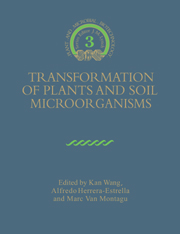Book contents
- Frontmatter
- Contents
- List of Contributors
- Series Preface
- Preface
- Acknowledgements
- Abbreviations and Terms
- Part I Transformation of Soil Microorganisms
- 1 Pseudomonas
- 2 Nocardioform and Coryneform Bacteria
- 3 Agrobacterium, Rhizobium, and Other Gram-Negative Soil Bacteria
- 4 Filamentous Fungi
- Part II Transformation of Cereal Crops
- Part III Transformation of Industrially Important Crops
- Index
1 - Pseudomonas
Published online by Cambridge University Press: 04 August 2010
- Frontmatter
- Contents
- List of Contributors
- Series Preface
- Preface
- Acknowledgements
- Abbreviations and Terms
- Part I Transformation of Soil Microorganisms
- 1 Pseudomonas
- 2 Nocardioform and Coryneform Bacteria
- 3 Agrobacterium, Rhizobium, and Other Gram-Negative Soil Bacteria
- 4 Filamentous Fungi
- Part II Transformation of Cereal Crops
- Part III Transformation of Industrially Important Crops
- Index
Summary
Introduction
Some pseudomonads exist in close association with plants. Best characterized are the phytopathogenic strains that are epiphytic colonists. Some of these are specific in their ability to infect only one plant species or are limited to particular cultivars within a species, as is true for some Pseudomonas syringae pathovars. Other pseudomonads colonize the rhizosphere. Best studied among the rhizosphere colonizers are strains that benefit plant health by their antagonism of pathogenic potential colonists (Défago & Haas, 1990). However, not all rhizosphere pseudomonads are of this sort: certain strains are neutral or even deleterious to the host plant.
Genetic manipulation is indispensible for the study of the interactions between plant and pseudomonad (Lindow, Panopoulos & McFarland, 1989). Introducing DNA into the pseudomonad is sometimes problematic: it is the subject of this chapter. The techniques developed for plant-related pseudomonads, based on prior expertise, have been those of conjugal transfer and direct transformation.
Transformation of Pseudomonas
Direct transformation of Pseudomonas syringae and P. fluorescens has been employed successfully (Mukhopadhyay, Mukhopadhyay & Mills, 1990), but optimal protocols may differ considerably from strain to strain. The effects of divalent cations used in inducing competence for transformation are highly strain and species dependent.
Electroporation is now an alternative to treatment with divalent cations for inducing DNA uptake; optimal protocols are probably less strain specific and the technique is potentially more efficient. In the future it may become the preferred way for introducing DNA into Pseudomonas. Its practicability has been demonstrated with Pseudomonas aeruginosa (Smith & Iglewski, 1989; Smith et al., 1990), P. chlororaphis and P. oxalaticus (Wirth, Friesenegger & Fiedler, 1989), and P. putida (Fiedler & Wirth, 1988; Trevors & Starodub, 1990).
- Type
- Chapter
- Information
- Transformation of Plants and Soil Microorganisms , pp. 3 - 9Publisher: Cambridge University PressPrint publication year: 1995



